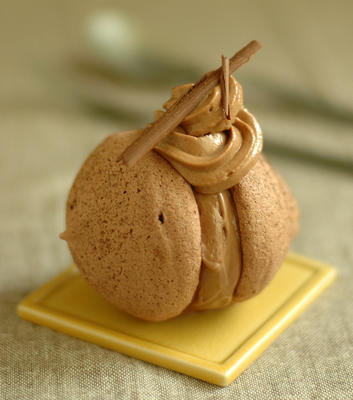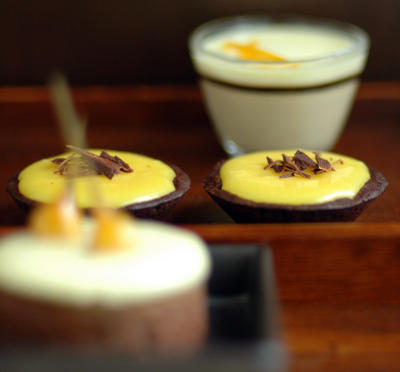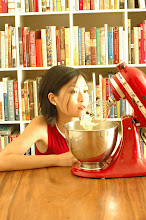I am an inveterate chocoholic. If I'm not actually stirring together some dark treat, chances are, I'm plotting the next recipe to try. And for those times when nothing but the most outrageously, gratifyingly, extravagantly chocolatey will do, I depend on the following favourites - potent shots in the arm for the incorrigible junkie. Given their extreme nature, modest doses are in order.
 Bittersweet Decadence Cookies (based on a recipe from Bittersweet by Alice Medrich)
Bittersweet Decadence Cookies (based on a recipe from Bittersweet by Alice Medrich)
"Ultrachocolatey and richer than sin, slightly crunchy on the outside with a divinely soft center, these are not delicate or subtle, but the jolt of bittersweet is irresistible." says Alice Medrich of her phenomenal cookies in her fabulous book, Bittersweet. For the best effect, please skip the packaged chips (which will neither taste right nor be the ideal size) in favour of craggy chunks hewn from a premium bar you like. While winningly fudgy when cooled, the cook deserves to eat one (or more) warm from the oven, generously rippled with seams of molten chocolate.
1/4 cup plain all-purpose flour; 1/4tsp double-action baking powder; 1/8 tsp fine sea salt; 8oz bittersweet or semisweet chocolate, chopped; 2Tbsp unsalted butter; 2 large eggs; 1/2 cup caster sugar; 2 cups pecans, broken into large chunks; 6oz bittersweet or semisweet chocolate, chopped into chunks approximately the size of a hazelnut
Preheat oven to 350 degrees Farenheit and line several cookie sheets with baking parchment. Mix together flour, baking powder and salt. Sift and set aside. Melt the 8oz of chocolate and butter in a large heatproof bowl over a pan of barely simmering water and stir till melted and smooth. Remove bowl from pan and set aside. In another heatproof bowl, whisk together eggs, sugar and vanilla. Set bowl over the pan of barely simmering water and stir till mixture is lukewarm to touch. Stir eggs into the warm (not hot) chocolate. Stir in flour mixture, followed by pecans and chocolate chunks. (Note: The batter is fairly liquid and not unlike a brownie batter in consistency. This is correct.) Scoop slightly heaped tablespoons of batter onto the prepared cookie sheets 1.5 inches apart and bake till surface is dry, set and glossy, but the centre is still gooey - about 12 to 14 minutes. Let cookies firm up on baking sheet for a minute before transferring them to racks to cool completely. Store in air tight containers.
Makes 36 cookies

Crème Chocolat (based on a recipe from La Maison du Chocolat by Robert Linxe)
La Maison du Chocolat is the quintessential Parisian chocolatier. Whether in Paris, Tokyo or London, the boutiques are exquisitely appointed, cocoons clad in sumptuous shades of cocoa brown, praline beige and caramel blond where the chocolate lover can indulge in the crème de la crème of confections. The packaging - sigh, the packaging - is without peer, the hue of the silkiest ganache and precisely trimmed in the recherche brown of the best bittersweet chocolate, crafted by the same box maker to that other venerable Parisian doyenne, the house of Hermès. The book, La Maison du Chocolat by Robert Linxe, as you would expect, is breathtakingly lush. Unfortunately, in the English edition published by Rizzoli, quite a few details and instructions appear to have been lost in translation (incidentally, not an uncommon occurrence in most of the French-to-English cookbooks I've come across). The Crème Chocolat recipe is one such instance in which a little culinary sleuthing is necessary to make sense of the instructions - the egg yolks mysteriously disappear after a cameo in the recipe's step 2. However, I am sufficiently enamoured with the book to overlook the oversights - viewing them as a practical opportunity to apply a soupcon of commonsense rather than a cause for grumbling makes my time in the kitchen that much more pleasant. Based on the deduction that the egg yolks should be stirred together with the hot milk to make a crème anglaise that's poured over the chocolate results in an unctuously rich cream that can only be described as onctueuse. Serve with a cookie-like thing on the side; I made some black-and-white sugar cookies, which being unobstrusive, know who's the star.
10 oz bittersweet chocolate, finely chopped; 3 egg yolks; 1/2 cup caster sugar; 2 cups whole milk; 1/2 vanilla bean; 1/2 cup unsweetened cocoa powder; 1/2 cup heavy cream, very well-chilled
Place the chocolate in a large mixing bowl and set aside. Whisk together the egg yolks and sugar in another large heatproof mixing bowl till well-combined. Stir in 1 cup of the milk. Place the remaining cup of milk in a small saucepan, along with the vanilla bean, split and seeds scraped into the milk. Bring slowly to the boil, whilst gradually whisking in the cocoa, stirring diligently to ensure it's absolutely smooth. Once it comes to the boil, take the pan off heat. Whisk 1/3 of the hot milk into the bowl of egg yolks to temper it, then gradually add the rest of the milk. Place this bowl of eggs and milk over a pan of barely simmering water. Stir constantly until the mixture thickens sufficiently to coat the back of a wooden spoon. Push mixture through a fine-meshed sieve or chinois into the bowl of finely chopped chocolate, discarding the vanilla bean. Let sit a moment or two. Stir very gently until chocolate is completely melted. Let cool, stirring occasionally. Chill for 1 hour. Meanwhile, whip the cream till soft peaks form. Add 1/3 of the chilled chocolate mixture to the whipped cream and fold gently to combine. Transfer this cream-chocolate mixture to the remaining chilled chocolate mixture and fold gently until combined. Pour into pretty serving dishes. Serve chilled.
Serves 4
 We came back a couple of days ago from a short break in Bangkok, where eating, drinking and shopping till you drop are in order. Unfortunately, no pictures - one can never have too much luggage space thanks to the superlative retail therapy available in the City of Angels, so the camera stayed back. No matter how much geng dtaeng bpet or hor mok pla we inhale whilst there, I always come home from a visit longing for the heady flavours of Thai food. Here, a pair of coconut-rich desserts, which while not Thai, sweetly end any piquant Southeast Asian meal on the right note.
We came back a couple of days ago from a short break in Bangkok, where eating, drinking and shopping till you drop are in order. Unfortunately, no pictures - one can never have too much luggage space thanks to the superlative retail therapy available in the City of Angels, so the camera stayed back. No matter how much geng dtaeng bpet or hor mok pla we inhale whilst there, I always come home from a visit longing for the heady flavours of Thai food. Here, a pair of coconut-rich desserts, which while not Thai, sweetly end any piquant Southeast Asian meal on the right note. Coconut Panna Cotta with Passion Fruit Coulis & Coconut Tuiles
Coconut Panna Cotta with Passion Fruit Coulis & Coconut Tuiles











